First Drive: 2016 Toyota Prius Review by Henny Hemmes +VIDEO
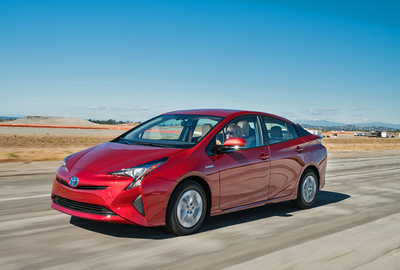 2016 Toyota Prius |
By Henny Hemmes
Senior European Editor
• SEE ALSO: Toyota Research and Buyers Guide
THE HAGUE - February 25, 2016: Until last November I would never have guessed that a Toyota Prius could ever be called a dynamic car. Never say never, a saying that now refers to the Prius.
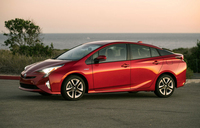 2016 Toyota Prius |
When the California test route of our first drive event lead us from Laguna Niguel to El Toro, I should have suspected that the Toyota team had something in store for us: A new model, developed on a brand new architecture. But during our drive to the former Marine Corps Air station near Irvine, neither my colleague nor myself did gave it a thought.
Upon approach to the huge airfield that nowadays is used for events, I remembered that this is the place where I won the ‘Hot Shoe Award’ with the Saleen S 302 Extreme, a 600 hp/6600 lb-ft strong Mustang. After our 30 mile drive on public roads we were impressed with the agility of the 2016 Prius and after we reached the Toyota tent along the old runway, we realized that we were going to drive the new model on a handling course. Indeed, a handling course…!
Shake up
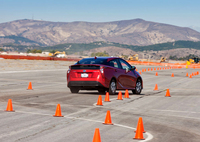 2016 Toyota Prius |
As soon as I saw an outgoing model parked nearby, we took the opportunity to compare old with new. The conclusion is short: The new Prius Toyota has taken giant steps forward.
This advances are primarily due to Akio Toyoda, Toyota's president and CEO, who recently started a shake up of the world's largest automaker. The development of the new Prius fitted within the plan and the new model should become the epitome of the innovations that had been put in motion at the company.
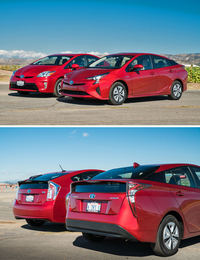 Toyota Prius - Old on left, New on right |
With the new generation, Akio wanted to offer - in particular - a less boring, more inspiring ride quality. Therefore, the development of the new modular platform 'Toyota New Global Architecture’ (TNGA) was essential. The Prius is the first model that is developed on this new chassis, which will be the foundation for the next Corolla and other models.
Well-considered choice
Compared to its predecessor, the TNGA-chassis of the 2016 Prius has a
more rigid structure. Strong and lightweight hot-stamped high strength
steel is applied throughout the body, and by using a special welding
technique, the result is a 60 per cent increase of torsional rigidity. The
new construction saved some 220 pounds, but this reduction disappeared due
the extra weight of the new rear suspension. Chief Engineer Toyoshima said
that this was a well-considered choice in order to achieve better
handling.
Moreover, the chassis has been constructed in such a way that it can also be equipped with all-wheel drive. There will be an AWD model in Japan, but there are no plans (yet) to offer such it in other countries,
Sleeker design
With the new architecture, the car’s center of gravity is nearly
an inch lower and the overall height is half an inch lower than of the
previous model. In this respect, relocating the battery from the trunk to
under the rear seats also must have had an effect. The lower center of
gravity allowed for the nose to drop nearly three inches, while the rear
part of the hood could drop 2.5 inches, providing a better view for the
driver.
The highest point of the roof has been brought forward by 6.7 inches, a measure that has an important influence on lowering the Cd value from 0.26 of the outgoing model to 0.24 of the new Prius, which is one of the lowest in the industry.
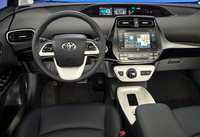 2016 Toyota Prius |
The car is longer, wider and lower, but the wheel base remained the same as before. With the forward raised roofline the headroom for the driver and the front passenger has been increased. The new roof line has hardly changed head room in the rear because Toyota uses an innovative design for the roof lining.
The seats are positioned lower in the car and provide a kind of anti-SUV-position, that better matches a car with a dynamic character.
Improved efficiency
Toyota has improved efficiency by upgrading the well-known 1.8-liter
VVT-I petrol engine, resulting in improved combustion for reaching a better
efficiency.
Thanks to automatically opening or closing slats in the grille, the airflow from outside is regulated depending on the outside temperature. Fuel consumption at temperatures below 23° Fahrenheit (-5° Celsius) is further reduced by the use of a dual cooling system (motor and heating). Horsepower is down from 98 to 96, but maximum torque of 105 pound-feet remained the same.
The electric motor is smaller and lighter and power is also down, in this case from 80-71 hp, while torque decreased from 153 to 120 lb-ft. The combined output is 121 hp, but as Toyota said that they have used a new way of measuring and that this cannot be compared with the output of 136 hp the previous model. Acceleration from 0-60 mph takes 10.6 seconds, which is about the same as before, while the top speed is limited at 112 mph. With better dynamics it remains to be seen if customers will drive the car as economically as they did with the previous Prius. But if you drive sensibly, around 50 mpg should be realistic, while in Eco drive and with an eco mind set it could well be a couple of miles more. And, mind you, that is without having to look out for charging stations!
On the winding roads back to our base, we enjoyed the confident feel of the new hybrid. The handling is engaging with good turn-in and less under-steer, so that the numbness of the old model is easily forgotten. The electric power steering gives better feed back and gets firmer in fast turns. But the vague center feeling is not gone.
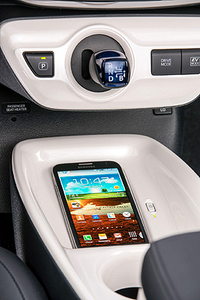 2016 Toyota Prius |
In the cabin it is quieter than before and nicer looking as well. The view to the rear has improved and a backup camera comes standard on all models.
The brake feel is somewhat different because the regenerative braking is combined with the hydraulic system. But you get used to it real quick.
There is a slew of comfort and safety features in the 2016 Prius such as standard Bi-LED headlamps with automatic leveling, two 4.2 inch full color TFT touch screens, heads-up display, connectivity through Entune Audio with integrated navigation (standard except on the base model). I should not forget to mention the Smart-flow mode of the air conditioning, that focuses airflow only to areas where occupants are seated to help optimize fuel economy and comfort.
There is much more, all depending on which of the six grades, that Toyota is offering for the new Prius: Two, Two Eco, Three, Three Touring, Four and the flagship Prius Four Touring.
Even with low gas prices and with consumer interest shifting to crossover vehicles, there is no doubt that the new Prius will be able to maintain its leadership in the world of ‘green’ cars. Let’s wait and see – until the prize giving at the New York Auto Show on March24 -what ranking the 2016 Prius will be able to grab in the World Car Awards, where it is one of five finalist for the 2016 World Green car of the Year.
Technical details 2016 Toyota Prius
IC-engine: 1.8-liter 4-cylinder in-line, 95 hp, 105 lb-ft.
Electric motor; permanent-magnet synchronous, 71 hp, 120 lb-ft
Combined power: 121 hp
Battery: 1.31-kWh nickel-metal-hydride (base model), or 0.75-kWh lithium-ion.
Transmission: continuously variable automatic
Length/width/height:178.7 in/69.3 in/58.1 in
Wheel base: 106.3 in
Cargo volume: 25-27 cu-ft
Weight: 3,050-3,100 lbs
Acceleration 0-60 mph: 10.0 sec
Top speed: 112 mph
Fuel consumption (est): EPA city/highway 54-58/50-53 mpg
Price: from $24,200 (MSRP).


